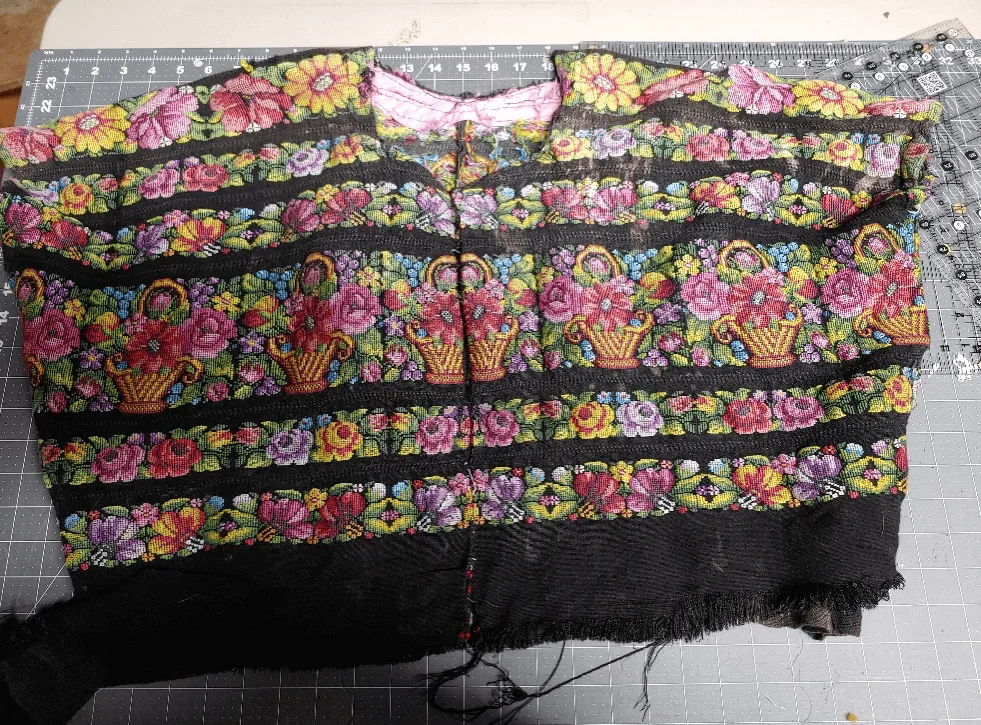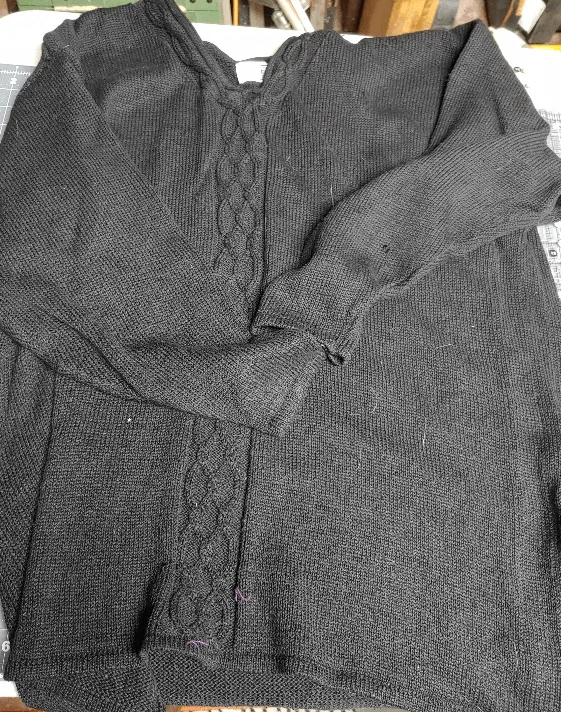Upcycling a Damaged Guatemalan Huipil and a Thrift Store Sweater into a Wearable Art Jacket


by Judy Gelzinis Donovan
In 2018 my husband and I spent 10 days in Guatemala on a fun “textile tour”. I collected many beautiful pieces of cloth—two suitcases full–but always found myself drawn to the “damaged goods” areas in the marketplaces where you could get for very little money lots of bits and pieces of older and sometimes damaged handwoven/hand-stitched textiles. I have always collected kimono parts and “hurt” kimono and haori coats, which inspire me to marry the undamaged parts with other lovely pieces of cloth to make lovely new garments. So why not do it Guatemalan style? One huipil in particular that called out to have a new life. The stitchery on it is dense heavy needlepoint-like embroidery. The huipil itself weighed close to 5 lbs. As with many of these garments, what wears out first is not the stitchery, but the cloth onto which the stitches were applied, and that was particularly true of this one. I believe it was made for a man because of its size. Simply trying to wear it in its enormity would have been unworkable. Here is the huipil in its original state.
For inspiration I hung the huipil on a hanger in my sewing studio for a few months after hand-washing it to remove the dust and to brighten the colors. I despise dry cleaning and knew that no one in its country of origin every dry-cleaned this huipil! One day while at the Mt. Airy Mercantile shop, I found a black cotton/rayon sweater in a size 44 that was in the “final sale” bin, priced at a hefty $8. The sweater was 70’s style, oversized, shoulder-padded and had a tiny bit of damage near the edge. But I loved the fabric anI thought it would have enough yardage to combine it with the huipil in some way to make a new garment.
I envisioned making a jacket with a front opening—possibly with a zipper—and attaching the sweater sleeves to the huipil and using the extra fabric from the sweater to lengthen the garment. Ultimately I did this but there was a great deal of surgery, trial-and-error and engineering involved beforehand. Having a dress form in my actual size was crucial—you can’t do this kind of thing without one of those!

First I had to work on the huipil. I turned it inside out and sliced off the damaged parts of the knit cotton fabric below the embroidery, hoping to attach the sweater fabric to what was left of it. The pink areas were a sort of facing that someone had crudely machine-sewed to the neckline. It was a mess and took me hours to carefully hand-pick out all of the black stitching. Then I marked the center of the front and sliced it open.

Next I had to add length to the jacket-to-be. The sweater had a nice cable on it that I centered on the back of the jacket, then measured to see how long a piece of sweater I had to slice.

I used fusible cotton tape and ironed it to the edge of the part of the sweater I wanted to amputate and attach to the huipil. Experience has taught me that you don’t simply CUT sweater knits. They have to be stabilized before you cut and serge. After serging the cut sweater part, I hand-basted it to the huipil before attempting to machine-sew the two pieces together. No one likes to rip mistakes on sweater knits!


Then I had to decide how long to make the sleeves, which I was going to machine-sew to the armholes of the huipil. It took several tries before I got the exact length I wanted, and found I had to slim down the sleeve somewhat, since they were from a very large sized sweater. I drew a chalk line on where I wanted to sew the new sleeve seam. After sewing the seam, I trimmed and serged it.


The jacket was coming together nicely, but the fit just wasn’t right. It was too large for me both at the side seams and in front. I solved the front problem by folding under each side of the opening about 2”. This worked out well since it made a beautiful finish to the front edge. I took in the sides about 2” tapering to where they met the sweater fabric. I saved all the pieces of beautiful embroidery that were cut off. To finish the neck, I applied a silk bias tape to the neck edge—remember I removed the funky pink ‘facing’ that was on the huipil.
The final step was to figure out if I could add pockets—and what to make them out of. I considered using other Guatemalan remnants to make patch pockets, but it just didn’t work. I also considered “hanging” pockets, but they were too clunky looking. Finally I decided to fuse pieces of the sweater remnants with a heavy fusible interfacing and then line them with black silk fabric. After auditioning many closure options—the zipper was too casual looking and buttons just detracted from the embroidery—I opted to hand sew some very large snaps to the opening. This preserved the pattern of the embroidery while making it easy to open and close. Velcro was considered, but again it was too inelegant for this garment. As an afterthought, I added a tiny remnant of the embroidery that I cut off during the seam surgery to each pocket, to connect these ‘after thought’ pockets to the magnificent embroidery of the huipil.
And here I am wearing my lovely new Mt-Airy-Guatemala Huipil jacket.








Really lovely. I also buy old huipiles. There’s a great place in Antigua maybe you visited called Nim Pot which means “big huipil”. They have tons of beautiful partly worn out huipiles, embroidered men’s pants, etc. I’ve been trying to think where this one might be from. Probably could be found with a bit of online research into huipiles. I’m sure the maker would be pleased to know her work didn’t go into the trash. I wasn’t quite sure if you were saying this embroidered piece might have been used by a man. Some men in the villages still wear handmade clothing, but men don’t wear huipiles. I hope you enjoyed Guatemala, my ‘second home’.
Beautiful work! Love it.
🤩 Gorgeous. Thank you for sharing your creative process in detail.
So beautiful. Glad you could give it a new life. Really learned from the thought that went into all of the techniques you used. Thanks so much for sharing. It was inspiring.